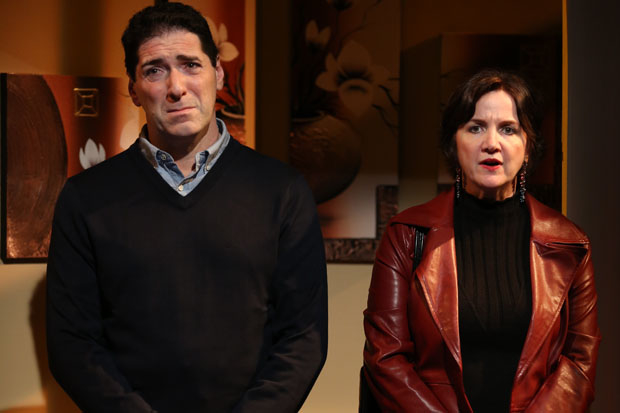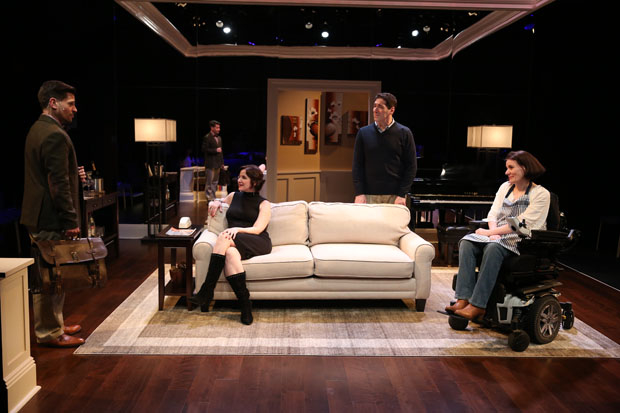Breaking Through The Fourth Wall

(© Carol Rosegg)
In the opening moments of A.R. Gurney's The Fourth Wall, Roger (Nicholas Viselli) and his friend Julia (Pamela Sabaugh) stare straight out at the audience, simultaneously aghast and bemused. Julia has come up from New York City to witness firsthand the bizarre layout in Roger's living room. Despondent about the presidency of George W. Bush, Roger's wife, Peggy (Ann Marie Morelli), has arranged the furniture to point in the direction of one completely blank wall, like a theatrical set. She has heard that liberals attend the theater, and she's convinced that if she could just break through the fourth wall, she could meet up with the resistance. Julia surmises that if she could just find an appropriate plot, she could bring the curtain down on Peggy's charade. Of course, it couldn't come down fast enough on this sluggish revival of a middling play.
It's a disappointing flop for Theater Breaking Through Barriers, the company that staged a hilarious revival of Charles Ludlam's The Artificial Jungle this time last year. TBTB admirably gives opportunities for disabled actors to perform in professional productions, so it is baffling that they would waste resources on such a rusty clunker.

(© Carol Rosegg)
The Fourth Wall made its world premiere in 1992 at Westport Country Playhouse, but its references to Bush II betray an adherence to the script of its 2002 New York debut with Primary Stages. While that New York audience was undoubtedly friendly to its liberal politics, it so offended Westport audiences that there were walkouts at every performance, prompting the gentlemanly Gurney to hold the house door for fleeing patrons so they wouldn't slam it in anger. Theatergoers might feel the urge to beat a premature retreat from this revival, but it's not because of the politics.
The play has aged terribly in the last 16 years, as the novelty of Urinetown-style metatheatrical humor has increasingly taken on the stale aroma of said town. While Gurney, as ever, has a good handle on these greater New York WASPS, it never really translates into compelling satire. The characters are too thinly sketched and the contrivance too improbable to really hold our attention. The Fourth Wall is essentially a New Yorker cartoon stretched to 90 minutes, so it seems appropriate when Julia stuffs a copy of the magazine into her purse in a moment that feels like needless filler.
Unfortunately, the cast doesn't elevate the mediocre material. Morelli delivers one-note melancholy, while Viselli plays an utterly forgettable rich white dude. Playing the role of a theater professor enlisted to find the plot, Stephen Drabicki seems to be more focused on remembering his lines than fully inhabiting his role (shakiness with the script is a problem across the board). Only Sabaugh approaches the commitment to seriousness that makes such comedy really work. It's hard not to grimace as laugh line after laugh line passes to the sound of crickets.

(© Carol Rosegg)
In the absence of funny performances, director Christopher Burris stages a competent (if occasionally self-defeating) production. In the published script, Gurney notes that his description of the set applies to a proscenium, but he hopes that a good designer could attain a similar effect on a more open stage. That's just what Bert Scott has attempted with his thrust set. While Burris doesn't take advantage of the set having three invisible walls in his staging, the close proximity of the audience cleverly prevents all but the most shameless viewers from making a Westport exit. Scott adorns the upstage wall with mirrors to make the room look grander, which results in an annoying glare from the poorly focused lighting (also by Scott). Courtney E. Butt's costumes capture the essence of these characters without making them more cartoonish than they already are. Sound designer Andy Evan Cohen has nicely programed several Cole Porter tunes on a player piano. The songs feel like more filler, but the cast sings them pleasantly enough (music direction by Dionne McClain-Feeney).
You could probably hear better renditions of these songs accompanied by funnier jokes at any given cabaret in the city, though. And as far as finding a good parody of liberal depression, you can switch on MSNBC. This company has done, and could still do, so much better.










